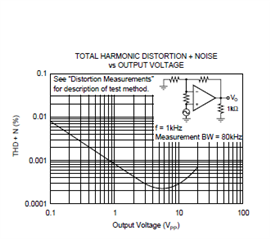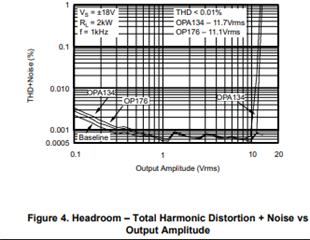Other Parts Discussed in Thread: OPA604, OPA134
I am trying to understand the LME49860 data sheet. This Opamp has a max supply voltage of+-22V which should give a max output swing of +-21.2V into 10k. Yet when I look at the data sheet, the graph shows a strong rise of distortion at about roughly +-12V - similiar to typical clipping beviour:

Do I missinterpret things or is this correct? If it was correct, does it mean that the opamp can withstand +-22V supply voltage, but it's headroom is similiar to a typical standard opamp running at +-15V? I'm confused...
Here's the graph of the OPA604, which runs at +-24V. This makes sense to me:

Or the OPA134, probably running at +-18V. Better that the LME49860 at +-22:

Is the LME49860 really behaving like that?
Thank you for reading,
Michael

